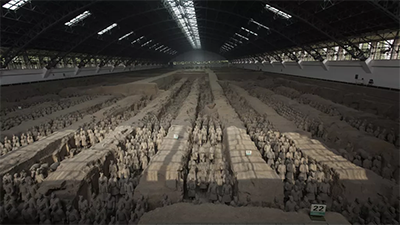Terracotta Army Guards Emperor's Tomb
The Terracotta Army is considered by some to be one of the wonders of the Ancient World. Made up of more than 8,000 life-size clay sculptures of armed warriors, the army guards the tomb of China's first emperor, Qin Shi-huang-di, who died in the 3rd Century B.C. 
The statues are individually life-like, with different facial expressions and hairstyles and even different-colored uniforms. Heights of the warriors range from 5-foot-8 to 6-foot-6, with the height increasing with military rank. Many of the warriors are armed with spears and swords and stand in battle formation, ready to do battle with anyone who disturbs the emperor's tomb. Some of the warriors were armed with crossbows that were designed to fire if disturbed. Some warriors are in terracotta chariots. Terracotta horses feature in the army as well, either pulling chariots or wearing saddles in anticipation of bearing riders. The bottom of each figure is clay, and the top is hollow, making it easier for the relatively tall statues to remain upright. In all, more than 700,000 workers built the underground city, which is 20 squares miles and includes not only the tomb, but also towers, palaces, and lanes to simulate an entire city, all of which remained buried for more than 2,000 years, until they were discovered in 1974 by a group of farmers digging a well.
Excavations in nearby pits have also turned up non-military terracotta figures, among them entertainers like acrobats and musicians and political officials, all of whom were identifiable by their "dress." |
|
Social Studies for Kids
copyright 2002–2026
David White



 Excavations have been meticulous and slow, in order to preserve the integrity of the figures. The majority of the figures are still buried. A group of 20 warriors and other objects discovered underground has appeared in special collections at museums in other countries.
Excavations have been meticulous and slow, in order to preserve the integrity of the figures. The majority of the figures are still buried. A group of 20 warriors and other objects discovered underground has appeared in special collections at museums in other countries.
